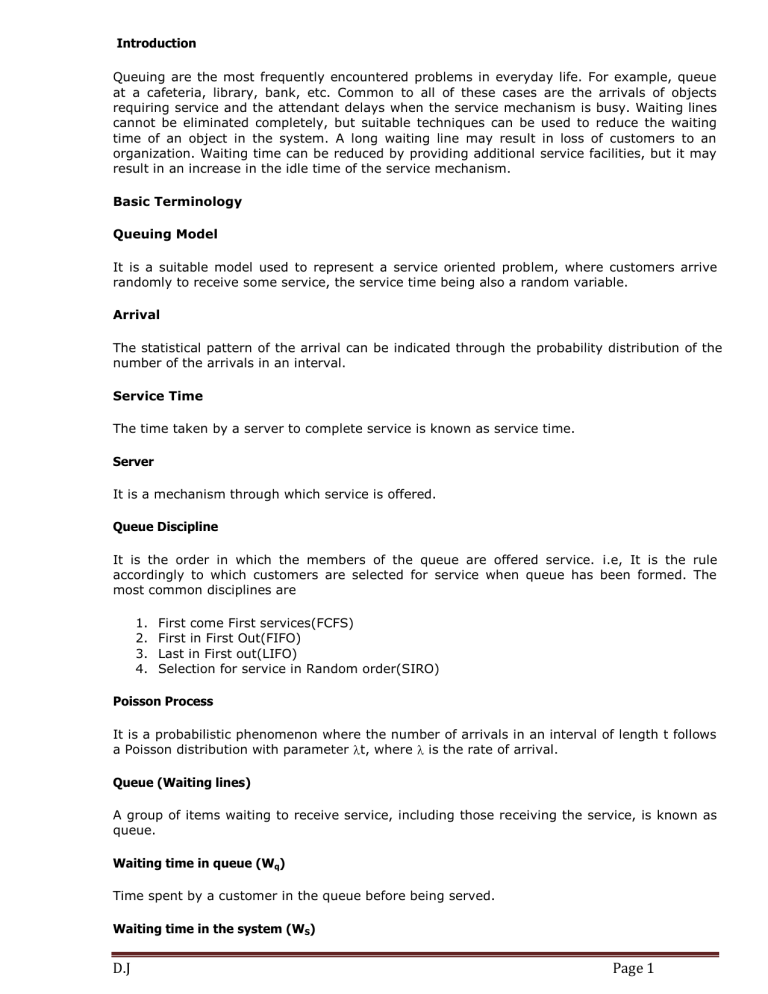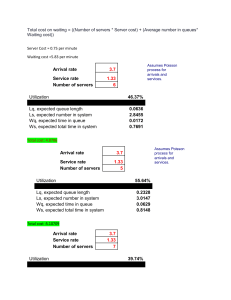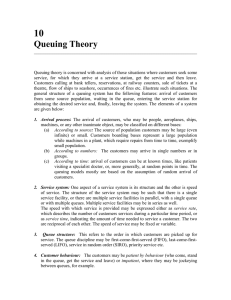
Introduction Queuing are the most frequently encountered problems in everyday life. For example, queue at a cafeteria, library, bank, etc. Common to all of these cases are the arrivals of objects requiring service and the attendant delays when the service mechanism is busy. Waiting lines cannot be eliminated completely, but suitable techniques can be used to reduce the waiting time of an object in the system. A long waiting line may result in loss of customers to an organization. Waiting time can be reduced by providing additional service facilities, but it may result in an increase in the idle time of the service mechanism. Basic Terminology Queuing Model It is a suitable model used to represent a service oriented problem, where customers arrive randomly to receive some service, the service time being also a random variable. Arrival The statistical pattern of the arrival can be indicated through the probability distribution of the number of the arrivals in an interval. Service Time The time taken by a server to complete service is known as service time. Server It is a mechanism through which service is offered. Queue Discipline It is the order in which the members of the queue are offered service. i.e, It is the rule accordingly to which customers are selected for service when queue has been formed. The most common disciplines are 1. 2. 3. 4. First come First services(FCFS) First in First Out(FIFO) Last in First out(LIFO) Selection for service in Random order(SIRO) Poisson Process It is a probabilistic phenomenon where the number of arrivals in an interval of length t follows a Poisson distribution with parameter t, where is the rate of arrival. Queue (Waiting lines) A group of items waiting to receive service, including those receiving the service, is known as queue. Waiting time in queue (Wq) Time spent by a customer in the queue before being served. Waiting time in the system (WS) D.J Page 1 It is the total time spent by a customer in the system. It can be calculated as follows: Waiting time in the system = Waiting time in queue + Service time Queue length (Lq) Number of persons in the system at any time Average length of line The number of customers in the queue per unit of time Average idle time (p0) The average time for which the system remains idle Bulk Arrivals If more than one customer enters the system at an arrival event, it is known as bulk arrivals. Note that bulk arrivals are not embodied in the models of the subsequent sections. Queuing System A queuing system can be completely described by The input (or arrival Patten) The service mechanism (or service pattern) The queuing discipline Customer’s behavior. General form of Queuing Model The general form of a queuing model as (a / b/ c): (d / e) 1. 2. 3. 4. a =Arrival Distribution b= c= d= Different types of Queuing Model 1. 2. 3. 4. D.J (M/M/1): (∞/FIFO) system (M/M/C): (∞/FIFO) system (M/M/1): (∞/FIFO) system (M/M/1): (∞/FIFO) system Page 2 Operating characteristic of a Queuing System Queuing length (Lq) System length(LS) Waiting time in queue (Wq) Waiting time in system (WS). Traffic intensity/ Utilization Factor It is the ratio of average arrival Where there are one server rate and average service rate Where there are multi server rate and average service rate Mean arrival rate Mean service rate Mean arrival rate Mean service rate C Application of Queuing Model 1. Business situations (departmental stores, cinema halls, petrol pumps, patients clinic, airlines counters etc.) 2. Scheduling of jobs in production control. 3. Solution of inventory control. The (M/M/1): (∞/FIFO) system This is a queuing model in which the arrival is Marcovian and departure distribution is also Marcovian, number of server is one and size of the queue is also Marcovian, no. of server is one and size of the queue is infinite and service discipline is 1st come 1st serve (FCFS) and the calling source is also finite . Assumptions and Notations 1. n= number of customers in system 2. µ=mean service rate 3. =mean arrival rate 4. Pn(t)=probability of n customers in system at time t 5. Probability of one arrival in the system during ∆t= ∆t+ O(h) 6. Probability of more than one arrival in the system during ∆t = O(h) 7. Probability of no arrival in the system during ∆t=1- ∆t+ O(h) 8. Probability of one customer being service in time ∆t= µ ∆t+ O(h) 9. Probability of more than one customer being service in time ∆t= O(h) 10. Probability of not a single customer being service in time ∆t=1- µ ∆t+ O(h) Let pn (t+∆t)be the probability of n customers in the system at the time t+∆t For n>0 Event D.J Number of customer at time t Number of customer arrivals in dt Number of customer departure in dt Number of customer at time t+dt Page 3 1 2 3 4 p n (t n n+1 n-1 n dt ) or, p n (t or, p n (t )(1 dt ) p n (t 0 0 1 1 dt )(1 p n (t ) dt ) dt dt ) p n 1 (t )(1 p n (t )( dt p n (t ) ( 0 1 0 1 ) pn dt ) dt )( dt ) p n 1 (t )( dt ) p n 1 (t ) p n 1 (t ) n n n n p n 1 (t )( dt ) p n 1 (t )( dt ) o(dt ) o(dt ) dt Taking the limit dt→0, we get the following differential equation, d p n (t ) dt ( ) pn p n 1 (t ) p n 1 (t ) …………………….(1) For n=0 Event Number of customer at time t 0 1 1 2 p0 (t dt ) p0 (t )(1 Or, p0 (t dt ) p0 (t ) p 0 (t dt ) dt p 0 (t ) Or, dt ) Number of customer arrivals in dt 0 0 p1 (t )( dt )(1 p0 (t )( dt ) p0 Number of customer departure in dt --1 Number of customer at time t+dt 0 0 dt ) o(dt ) p1 (t )( dt ) o(dt ) p1 (t ) o(dt ) ……………………………….(2) dt Taking the limit dt→0, we get the following differential equation, d p0 (t ) dt p1 (t ) , when n=0. p0 For steady state conditions d p n (t ) dt p ' n (t ) 0 Therefore, the above reduces to differential equations, ( ) pn p0 p1 We have p1 D.J pn 1 pn 1 0 , where n>0 0 , where n=0. p0 . Putting n=1, 2, 3,…n we get Page 4 2 p2 p0 3 p3 p0 …………………….. n p0 , where n>0 pn n p0 , Hence 1 pn 1 Characteristics n 1. Expected Length of Queue ( Lq ) (n 1) p n i 1 n n n pn i 1 pn i 1 LS (1 p0 ) LS [1 (1 )] LS n 2. Expected Length of System: ( LS ) n pn i 1 n n p0 n i 1 n n n1 i 1 n 1 n n 1 i 1 1 1 2 3 2 ...... 1 Therefore, LS D.J Page 5 LS 3. Waiting time in System: (WS ) 4. Variance of Queue length: (Wq ) 1 WS ( ) Working Formulae 1. Probability of zero units in the queue ( P0 ) 1 2 2. Average queue length ( Lq ) ( ) 3. Average number of units in the system ( LS ) 4. Average waiting time of an arrival (Wq ) ( ) 5. Average waiting time of an arrival in the system (WS ) 1 Example 1: A Television repairman finds that the time spent on his jobs has an exponential distribution with mean 30 minuets. If he repairs the sets in the order in which they come in, and if the arrivals of sets are approximately Poisson with an average rate of 10 per 8 hours day which is the repairs man idle time each day ?Find the expected number of units in the system and in the queue? Solution: it is a (M\M\1: (∞\FCFS) queuing system. Where, = mean arrival rate =10/8 units per hour µ=mean service rate =2mins per hour. Therefore = /µ=10/8.2=5/8 1. Expected number of units in the system LS 5 sets 3 1 5 2 2. Expected number of units in the queue ( Lq ) (1 ) = ( Lq ) 2 8 (1 5 ) 8 = 3. Probability of repairman being idle=probability of having no T.V sets in the system ( p0 ) 1 =1 5 3 = 8 8 4. Therefore repairman will remain idle for 3 8 3 hours per day. 8 Exercises 1. What do you understand by a queue? Give some important applications of queuing theory. D.J Page 6 2. A barber with a one-man shop takes exactly 30 minutes to complete one haircut. If customers arrive according to a Poisson process at a rate of one every 40 minutes, how long on the average must a customer wait for service? 3. a) Define a queue. What are the basic characteristics of a queuing system? b) Prove that Lq c) Prove that Ls 4. For a LS of ( M / M / 1) : ( of ( M / M / 1) : ( / FCFS ) queuing model. WBUT CH-08 / FCFS ) queuing model ( M / M / 1) : ( / FCFS ) queuing model, derive the expressions for: WBUT a) The steady state equation. b) Expected number of customers in the system. c) Expected number of customers in the queue. 5. A two channel waiting line with Poisson arrival has a mean arrival rate of 50 per hour and exponential service with a mean service rate of 75 per hour for each channel. Find (i) (ii) D.J The probability of the empty system. The probability that an arrival in the system will have to wait. Page 7



